1. Introduction to USART
- Universal Synchronous Asynchronous Receiver and Transmitter is a serial communication device that provides flexibility for full duplex data exchange with external devices. Unlike USART, there is also a UART(Universal Asynchronous Receiver and Transmitter), which cuts out the synchronous communication function on the basis of USART and only asynchronous communication. Simple distinction between synchronous and asynchronous means that when communicating, there is no need to provide external clock output. Usually, the serial communication we use is UART.
- Serial communication generally transmits data in frame format, that is, frame by frame, each frame contains start signal, data information, stop information, and possibly check information. USART specifies these transmission parameters, and of course it is not the only parameter value. Many parameter values can be customized, just to enhance its compatibility.
2. Register Address Method
(1) New Keil Project
New Project - > New uVision Project.

Select the storage path, name the file and save it.

Select the chip and OK.
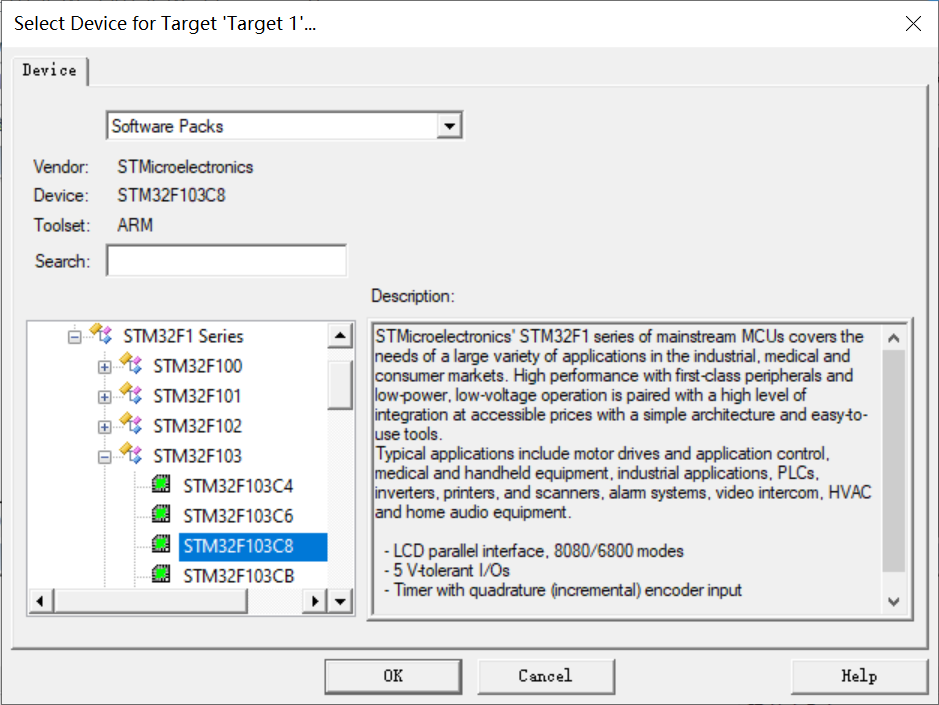
This step is not selected, click OK.

(2) Write code and compile
Right-click Source Group1 to select ADD New item to Gourp....

Select Asm File (.s) and name it. Click ADD.

hello.s:
;RCC Register Address Image
RCC_BASE EQU 0x40021000
RCC_CR EQU (RCC_BASE + 0x00)
RCC_CFGR EQU (RCC_BASE + 0x04)
RCC_CIR EQU (RCC_BASE + 0x08)
RCC_APB2RSTR EQU (RCC_BASE + 0x0C)
RCC_APB1RSTR EQU (RCC_BASE + 0x10)
RCC_AHBENR EQU (RCC_BASE + 0x14)
RCC_APB2ENR EQU (RCC_BASE + 0x18)
RCC_APB1ENR EQU (RCC_BASE + 0x1C)
RCC_BDCR EQU (RCC_BASE + 0x20)
RCC_CSR EQU (RCC_BASE + 0x24)
;AFIO Register Address Image
AFIO_BASE EQU 0x40010000
AFIO_EVCR EQU (AFIO_BASE + 0x00)
AFIO_MAPR EQU (AFIO_BASE + 0x04)
AFIO_EXTICR1 EQU (AFIO_BASE + 0x08)
AFIO_EXTICR2 EQU (AFIO_BASE + 0x0C)
AFIO_EXTICR3 EQU (AFIO_BASE + 0x10)
AFIO_EXTICR4 EQU (AFIO_BASE + 0x14)
;GPIOA Register Address Image
GPIOA_BASE EQU 0x40010800
GPIOA_CRL EQU (GPIOA_BASE + 0x00)
GPIOA_CRH EQU (GPIOA_BASE + 0x04)
GPIOA_IDR EQU (GPIOA_BASE + 0x08)
GPIOA_ODR EQU (GPIOA_BASE + 0x0C)
GPIOA_BSRR EQU (GPIOA_BASE + 0x10)
GPIOA_BRR EQU (GPIOA_BASE + 0x14)
GPIOA_LCKR EQU (GPIOA_BASE + 0x18)
;GPIO C Port Control
GPIOC_BASE EQU 0x40011000
GPIOC_CRL EQU (GPIOC_BASE + 0x00)
GPIOC_CRH EQU (GPIOC_BASE + 0x04)
GPIOC_IDR EQU (GPIOC_BASE + 0x08)
GPIOC_ODR EQU (GPIOC_BASE + 0x0C)
GPIOC_BSRR EQU (GPIOC_BASE + 0x10)
GPIOC_BRR EQU (GPIOC_BASE + 0x14)
GPIOC_LCKR EQU (GPIOC_BASE + 0x18)
;Serial Port 1 Control
USART1_BASE EQU 0x40013800
USART1_SR EQU (USART1_BASE + 0x00)
USART1_DR EQU (USART1_BASE + 0x04)
USART1_BRR EQU (USART1_BASE + 0x08)
USART1_CR1 EQU (USART1_BASE + 0x0c)
USART1_CR2 EQU (USART1_BASE + 0x10)
USART1_CR3 EQU (USART1_BASE + 0x14)
USART1_GTPR EQU (USART1_BASE + 0x18)
;NVIC Register Address
NVIC_BASE EQU 0xE000E000
NVIC_SETEN EQU (NVIC_BASE + 0x0010)
;SETENA Starting address of register array
NVIC_IRQPRI EQU (NVIC_BASE + 0x0400)
;Starting address of interrupt priority register array
NVIC_VECTTBL EQU (NVIC_BASE + 0x0D08)
;Address of vector table offset register
NVIC_AIRCR EQU (NVIC_BASE + 0x0D0C)
;Address of application interrupt and reset control registers
SETENA0 EQU 0xE000E100
SETENA1 EQU 0xE000E104
;SysTick Register Address
SysTick_BASE EQU 0xE000E010
SYSTICKCSR EQU (SysTick_BASE + 0x00)
SYSTICKRVR EQU (SysTick_BASE + 0x04)
;FLASH Buffer Register Address Image
FLASH_ACR EQU 0x40022000
;SCB_BASE EQU (SCS_BASE + 0x0D00)
MSP_TOP EQU 0x20005000
;Main Stack Start Value
PSP_TOP EQU 0x20004E00
;Process Stack Start Value
BitAlias_BASE EQU 0x22000000
;Beginning address of bit band alias area
Flag1 EQU 0x20000200
b_flas EQU (BitAlias_BASE + (0x200*32) + (0*4))
;Bit Address
b_05s EQU (BitAlias_BASE + (0x200*32) + (1*4))
;Bit Address
DlyI EQU 0x20000204
DlyJ EQU 0x20000208
DlyK EQU 0x2000020C
SysTim EQU 0x20000210
;Constant Definition
Bit0 EQU 0x00000001
Bit1 EQU 0x00000002
Bit2 EQU 0x00000004
Bit3 EQU 0x00000008
Bit4 EQU 0x00000010
Bit5 EQU 0x00000020
Bit6 EQU 0x00000040
Bit7 EQU 0x00000080
Bit8 EQU 0x00000100
Bit9 EQU 0x00000200
Bit10 EQU 0x00000400
Bit11 EQU 0x00000800
Bit12 EQU 0x00001000
Bit13 EQU 0x00002000
Bit14 EQU 0x00004000
Bit15 EQU 0x00008000
Bit16 EQU 0x00010000
Bit17 EQU 0x00020000
Bit18 EQU 0x00040000
Bit19 EQU 0x00080000
Bit20 EQU 0x00100000
Bit21 EQU 0x00200000
Bit22 EQU 0x00400000
Bit23 EQU 0x00800000
Bit24 EQU 0x01000000
Bit25 EQU 0x02000000
Bit26 EQU 0x04000000
Bit27 EQU 0x08000000
Bit28 EQU 0x10000000
Bit29 EQU 0x20000000
Bit30 EQU 0x40000000
Bit31 EQU 0x80000000
;Vector table
AREA RESET, DATA, READONLY
DCD MSP_TOP ;Initialize the main stack
DCD Start ;Reset Vector
DCD NMI_Handler ;NMI Handler
DCD HardFault_Handler ;Hard Fault Handler
DCD 0
DCD 0
DCD 0
DCD 0
DCD 0
DCD 0
DCD 0
DCD 0
DCD 0
DCD 0
DCD 0
DCD SysTick_Handler ;SysTick Handler
SPACE 20 ;Reserved space 20 bytes
;Code snippet
AREA |.text|, CODE, READONLY
;Main program start
ENTRY
;Indicates that the program starts here
Start
;Clock System Settings
ldr r0, =RCC_CR
ldr r1, [r0]
orr r1, #Bit16
str r1, [r0]
;Open external crystal vibration enable
;Start External 8 M Crystal oscillator
ClkOk
ldr r1, [r0]
ands r1, #Bit17
beq ClkOk
;Waiting for external crystal vibration to be ready
ldr r1,[r0]
orr r1,#Bit17
str r1,[r0]
;FLASH Buffer
ldr r0, =FLASH_ACR
mov r1, #0x00000032
str r1, [r0]
;Set up PLL Phase-locked loop multiplier is 7,HSE Input nonfrequency Division
ldr r0, =RCC_CFGR
ldr r1, [r0]
orr r1, #(Bit18 :OR: Bit19 :OR: Bit20 :OR: Bit16 :OR: Bit14)
orr r1, #Bit10
str r1, [r0]
;start-up PLL Phase-locked loop
ldr r0, =RCC_CR
ldr r1, [r0]
orr r1, #Bit24
str r1, [r0]
PllOk
ldr r1, [r0]
ands r1, #Bit25
beq PllOk
;Choice PLL Clock as system clock
ldr r0, =RCC_CFGR
ldr r1, [r0]
orr r1, #(Bit18 :OR: Bit19 :OR: Bit20 :OR: Bit16 :OR: Bit14)
orr r1, #Bit10
orr r1, #Bit1
str r1, [r0]
;Other RCC Related Settings
ldr r0, =RCC_APB2ENR
mov r1, #(Bit14 :OR: Bit4 :OR: Bit2)
str r1, [r0]
;IO port settings
ldr r0, =GPIOC_CRL
ldr r1, [r0]
orr r1, #(Bit28 :OR: Bit29)
;PC.7 Output mode,Maximum Speed 50 MHz
and r1, #(~Bit30 & ~Bit31)
;PC.7 Universal Push-Pull Output Mode
str r1, [r0]
;PA9 Serial 0 Launch Foot
ldr r0, =GPIOA_CRH
ldr r1, [r0]
orr r1, #(Bit4 :OR: Bit5)
;PA.9 Output mode,Maximum Speed 50 MHz
orr r1, #Bit7
and r1, #~Bit6
;10: Push-Pull Output Mode with Reuse Function
str r1, [r0]
ldr r0, =USART1_BRR
mov r1, #0x271
str r1, [r0]
;Configure baud rate-> 115200
ldr r0, =USART1_CR1
mov r1, #0x200c
str r1, [r0]
;USART Module Always Enable Send and Receive Enables
;71 02 00 00 2c 20 00 00
;AFIO Parameter Settings
;Systick Parameter Settings
ldr r0, =SYSTICKRVR
;Systick Loading Initial Value
mov r1, #9000
str r1, [r0]
ldr r0, =SYSTICKCSR
;Set up,start-up Systick
mov r1, #0x03
str r1, [r0]
;NVIC
;ldr r0, =SETENA0
;mov r1, 0x00800000
;str r1, [r0]
;ldr r0, =SETENA1
;mov r1, #0x00000100
;str r1, [r0]
;Switch to user-level threading mode
ldr r0, =PSP_TOP
;Initialize Thread Stack
msr psp, r0
mov r0, #3
msr control, r0
;Initialization SRAM register
mov r1, #0
ldr r0, =Flag1
str r1, [r0]
ldr r0, =DlyI
str r1, [r0]
ldr r0, =DlyJ
str r1, [r0]
ldr r0, =DlyK
str r1, [r0]
ldr r0, =SysTim
str r1, [r0]
;Main cycle
main
ldr r0, =Flag1
ldr r1, [r0]
tst r1, #Bit1
;SysTick Generate 0.5s,Location bit 1
beq main ;0.5s Sign not yet positioned
;0.5s Flag already in place
ldr r0, =b_05s
;Bit-band operation zeroing 0.5s sign
mov r1, #0
str r1, [r0]
bl LedFlas
mov r0, #'H'
bl send_a_char
mov r0, #'e'
bl send_a_char
mov r0, #'l'
bl send_a_char
mov r0, #'l'
bl send_a_char
mov r0, #'o'
bl send_a_char
mov r0, #' '
bl send_a_char
mov r0, #'w'
bl send_a_char
mov r0, #'o'
bl send_a_char
mov r0, #'r'
bl send_a_char
mov r0, #'l'
bl send_a_char
mov r0, #'d'
bl send_a_char
mov r0, #'\n'
bl send_a_char
b main
;Subprogram serial port 1 sends a character
send_a_char
push {r0 - r3}
ldr r2, =USART1_DR
str r0, [r2]
b1
ldr r2, =USART1_SR
ldr r2, [r2]
tst r2, #0x40
beq b1
;Send complete(Transmission complete)wait for
pop {r0 - r3}
bx lr
;subroutine led Twinkle
LedFlas
push {r0 - r3}
ldr r0, =Flag1
ldr r1, [r0]
tst r1, #Bit0
;bit0 Flashing Mark Bit
beq ONLED ;Open for 0 led lamp
;Close for 1 led lamp
ldr r0, =b_flas
mov r1, #0
str r1, [r0]
;Flash flag position is 0,Next state is on light
;PC.7 Output 0
ldr r0, =GPIOC_BRR
ldr r1, [r0]
orr r1, #Bit7
str r1, [r0]
b LedEx
ONLED
;Open for 0 led lamp
ldr r0, =b_flas
mov r1, #1
str r1, [r0]
;Flash flag position 1,Next state is off light
;PC.7 Output 1
ldr r0, =GPIOC_BSRR
ldr r1, [r0]
orr r1, #Bit7
str r1, [r0]
LedEx
pop {r0 - r3}
bx lr
;Exception Program
NMI_Handler
bx lr
HardFault_Handler
bx lr
SysTick_Handler
ldr r0, =SysTim
ldr r1, [r0]
add r1, #1
str r1, [r0]
cmp r1, #500
bcc TickExit
mov r1, #0
str r1, [r0]
ldr r0, =b_05s
;Clock tick counter settings greater than or equal to 500 zeroes 0.5s Sign bits
;Bit band operation position 1
mov r1, #1
str r1, [r0]
TickExit
bx lr
ALIGN
;By using zero or empty instructions NOP Fill,To align the current position with a specified boundary
END
Click on the magic wand, as checked in the figure, to generate the hex file.

Compile to generate the hex file.
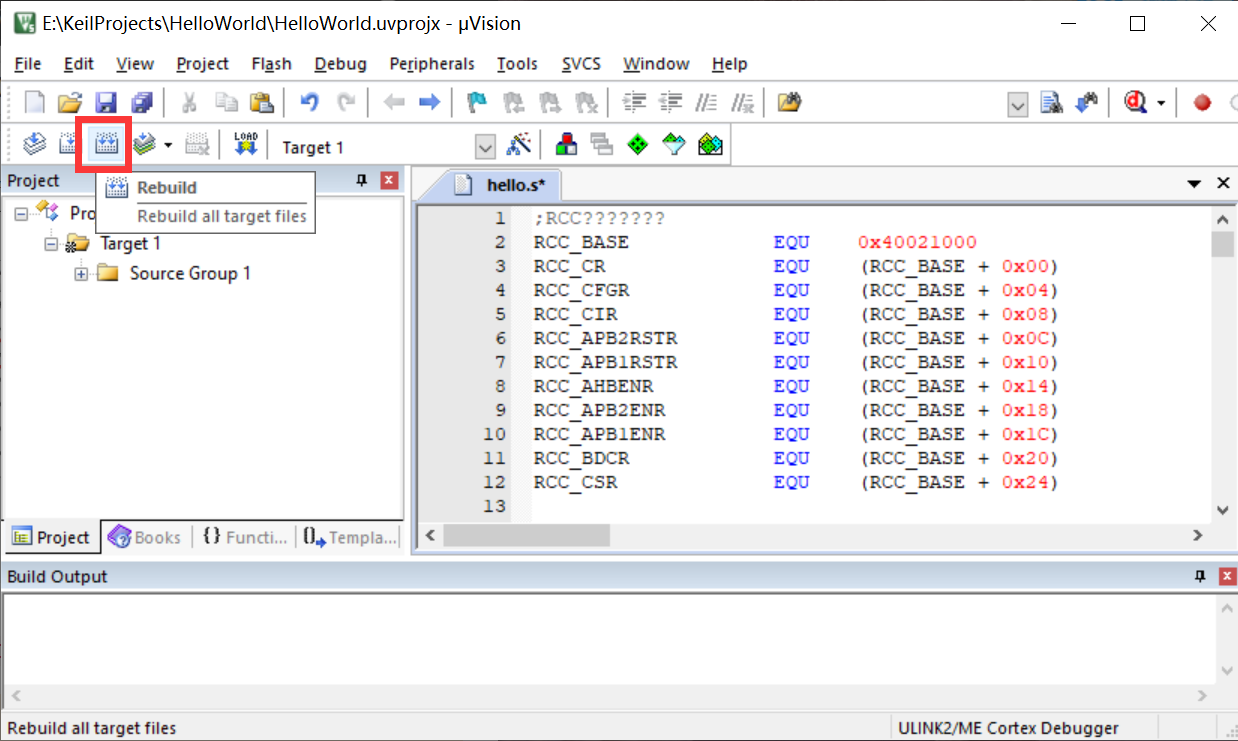

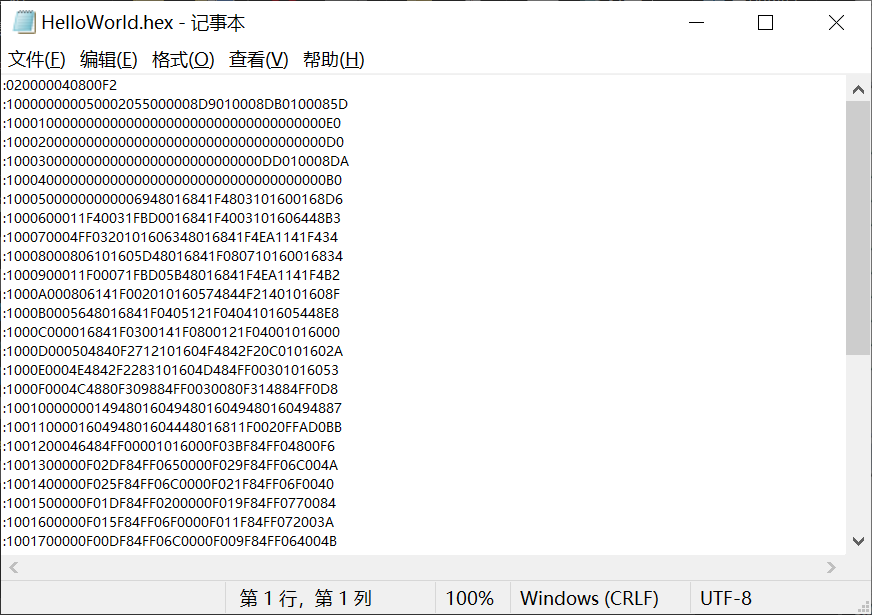
(3) Burning
Connect circuit.
Connect Serial Port
TXD-A10
RXD-A9
3V3-3V3
GND-G
boot0 at 1 and boot1 at 0 during burning
Burning, using either FlyMcu or Mcuisp, was successful as shown in the figure.
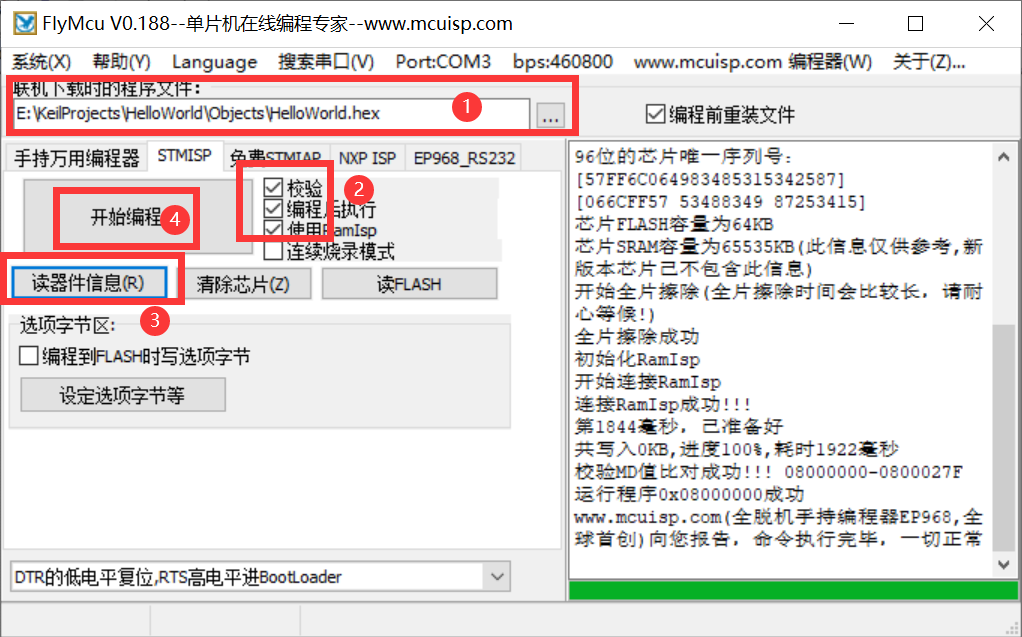
(4) Serial output results
At this point boot0 is set at 0, boot1 at 1
Circuit diagram:
go Wildfire Product Data Download Center Download the STM32F103C8T6 core board, which contains relevant information.
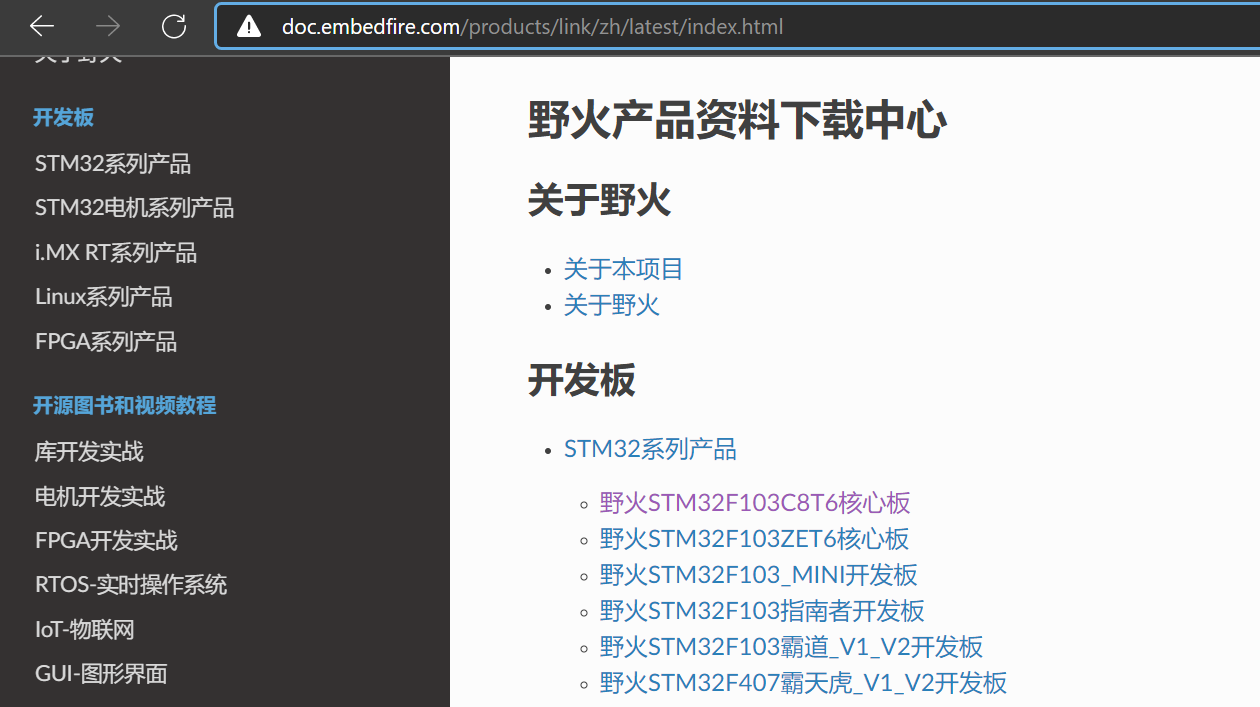
Debug with wildfire multi-function debugging assistant.
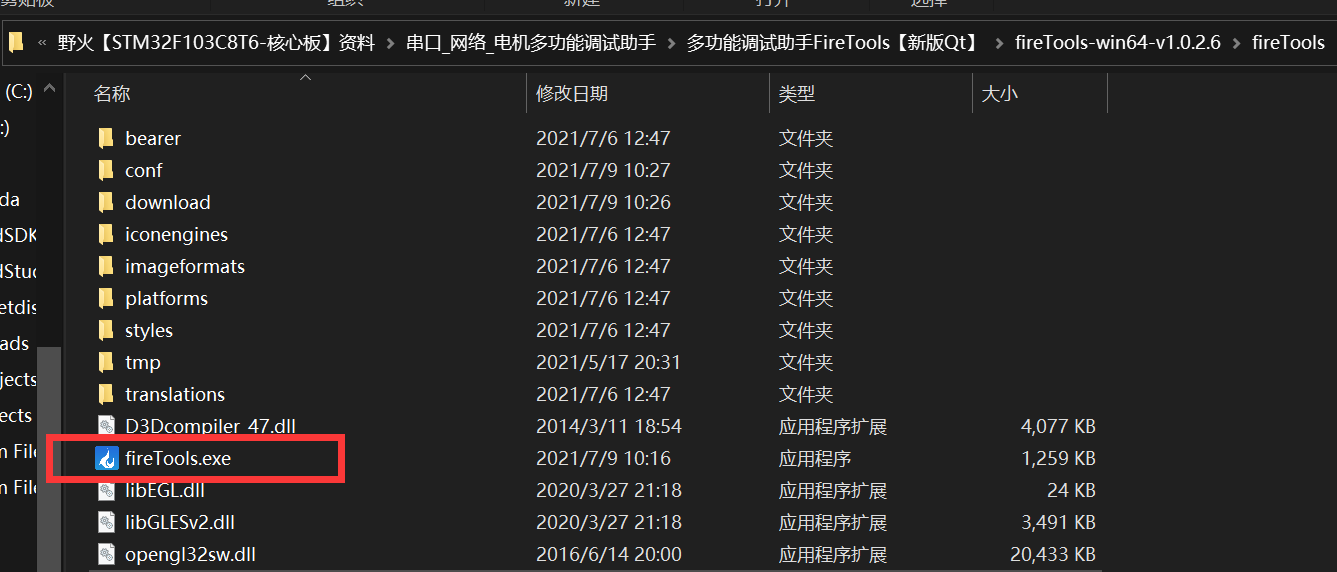
Open the serial port.

Output results.
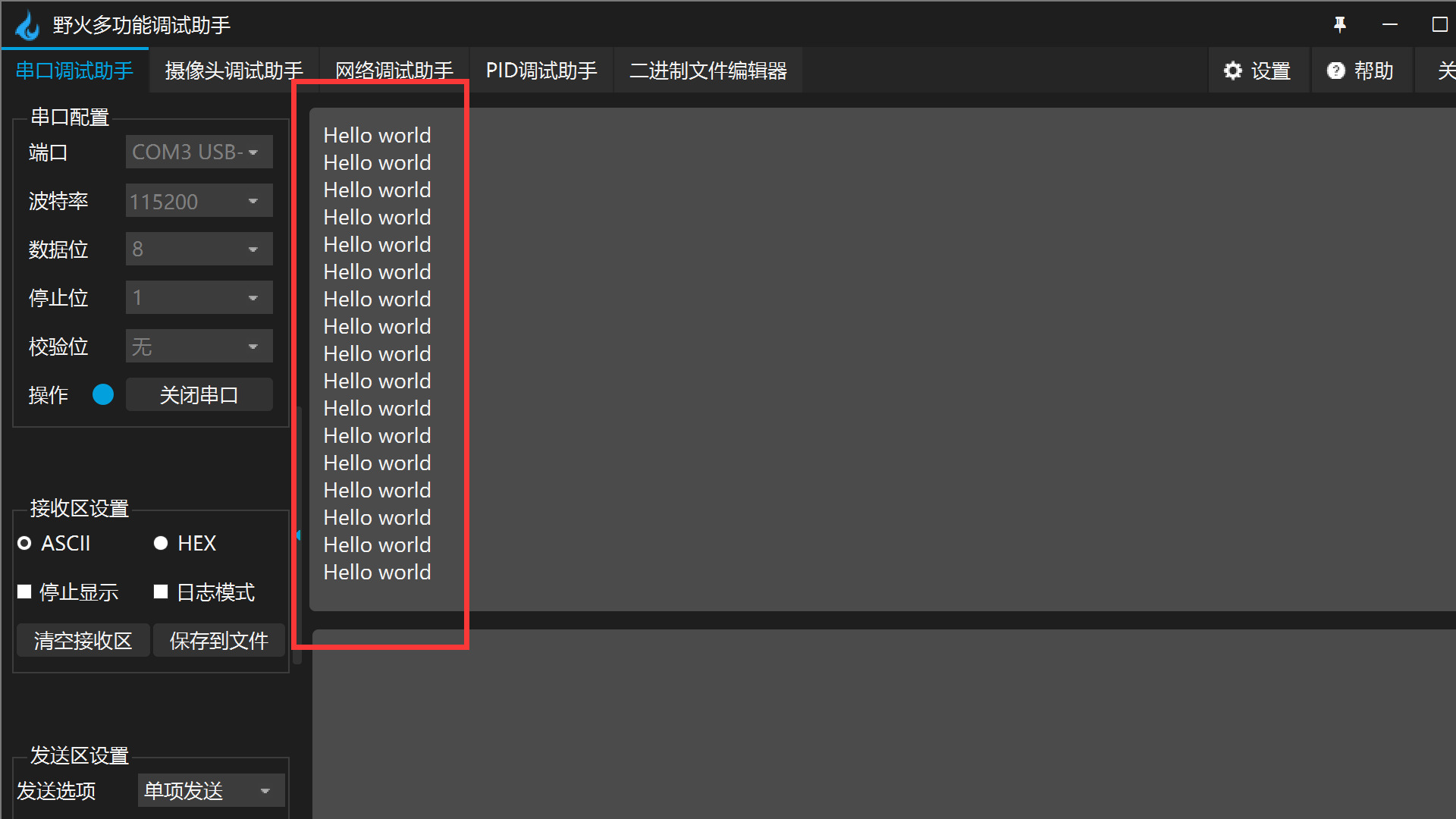
3. HAL Library Mode
(1) CubeMX Creation Project
New File->New Project.

Choose chip, dot star ⭐, Then Start Project on the right.
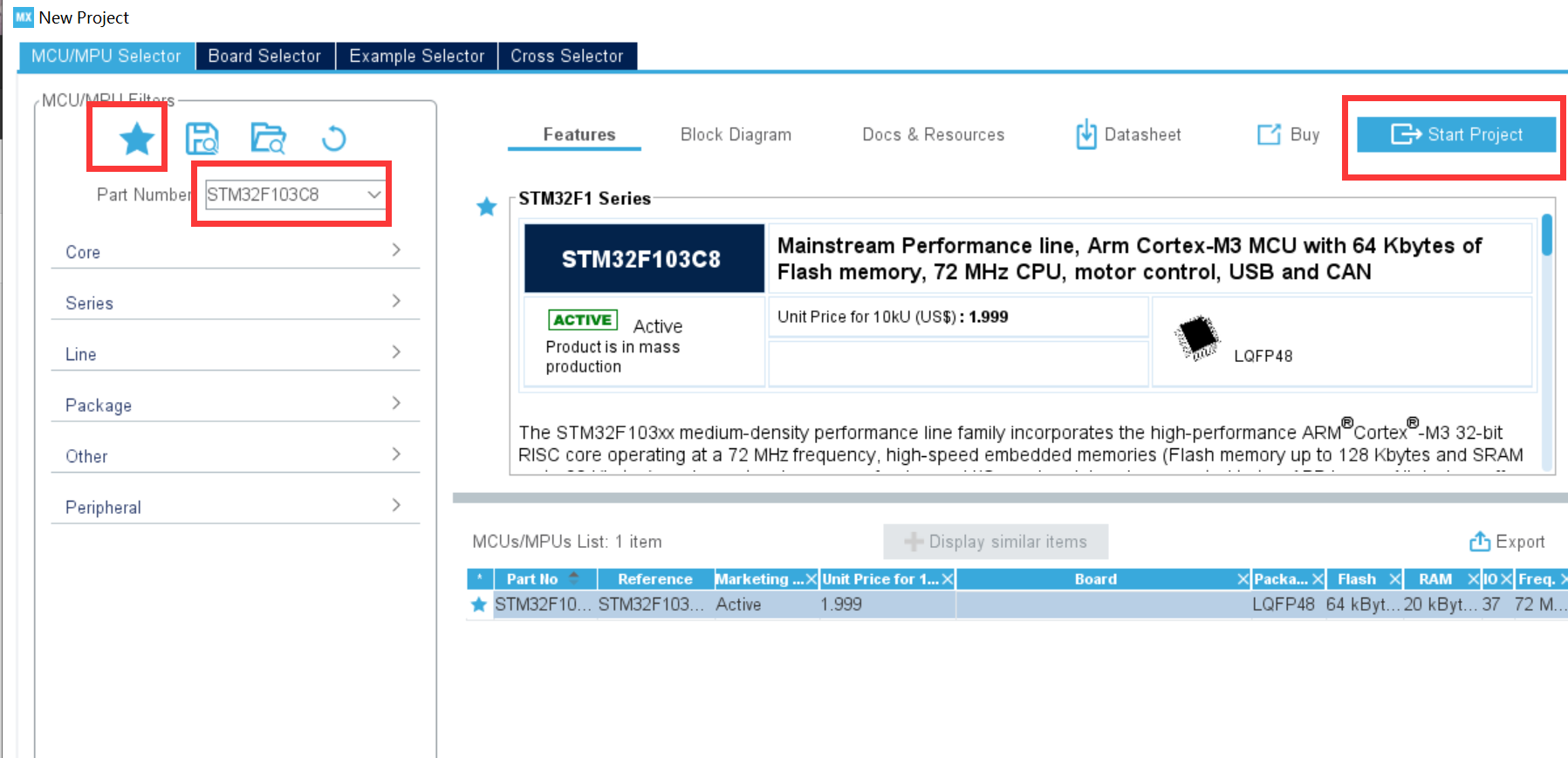
Rcc clock configuration, click System Core, click RCC, and select Crystal/Ceramic Resonator in the HSE option.
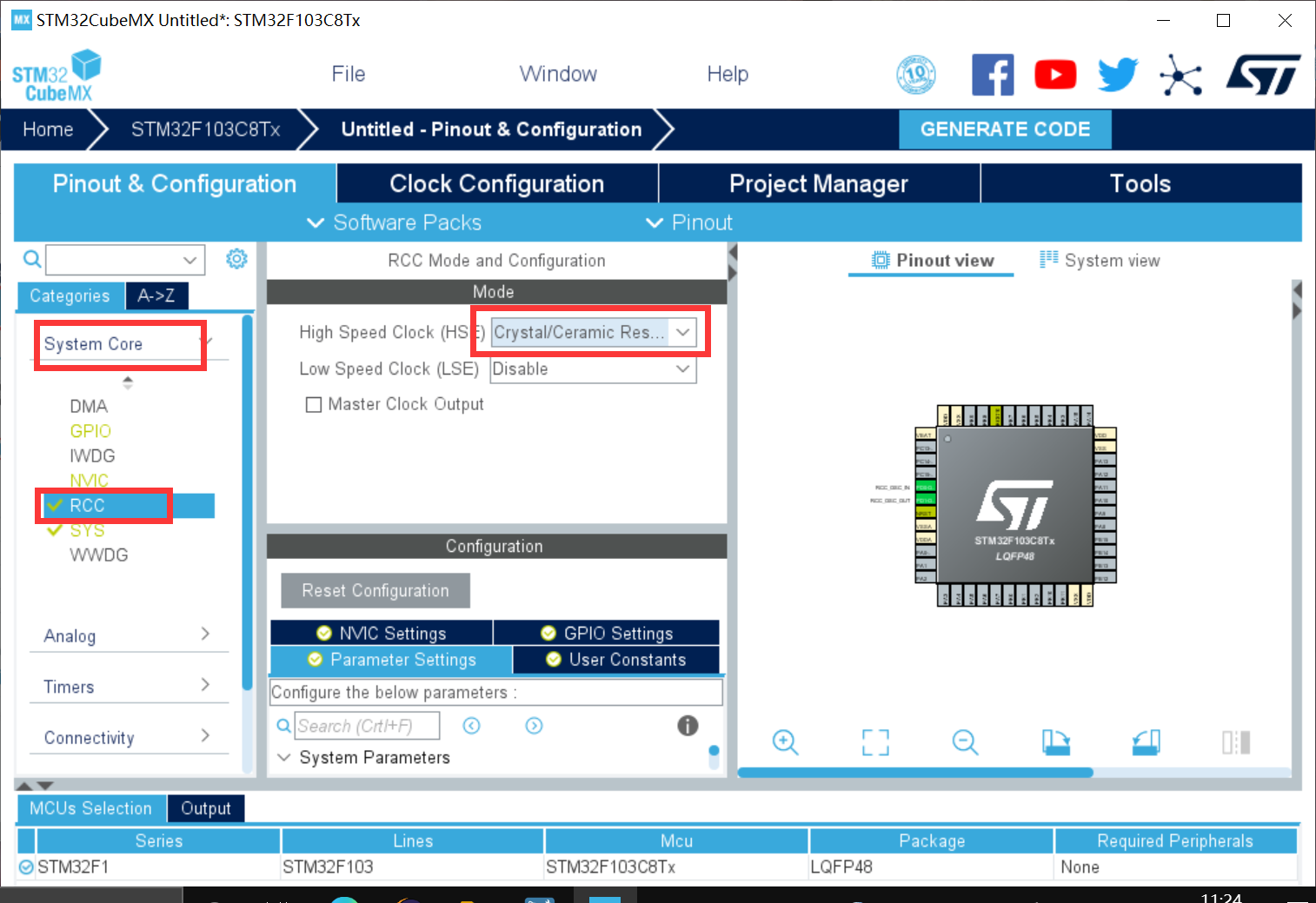
Pin A4.
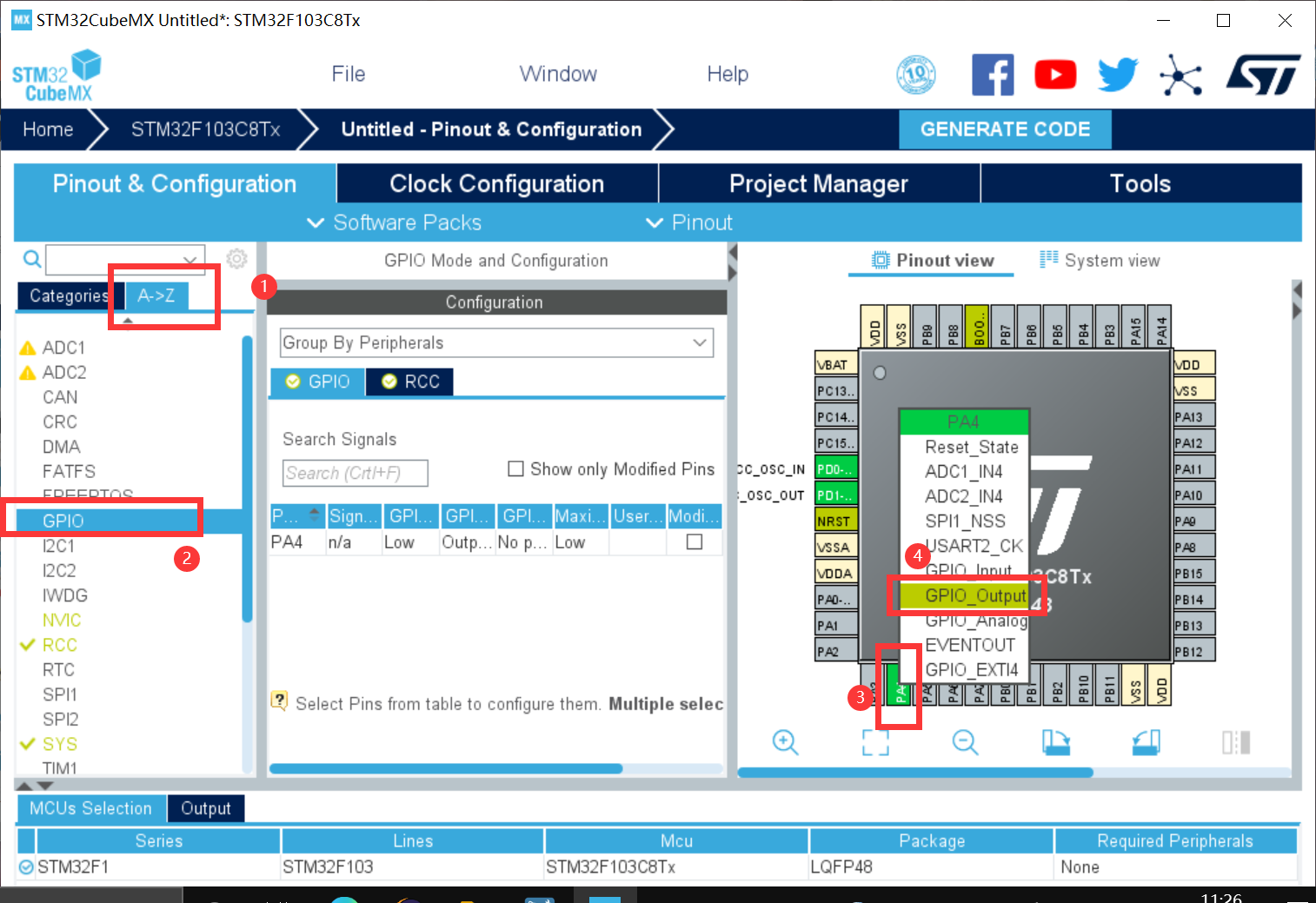
Set USART1.
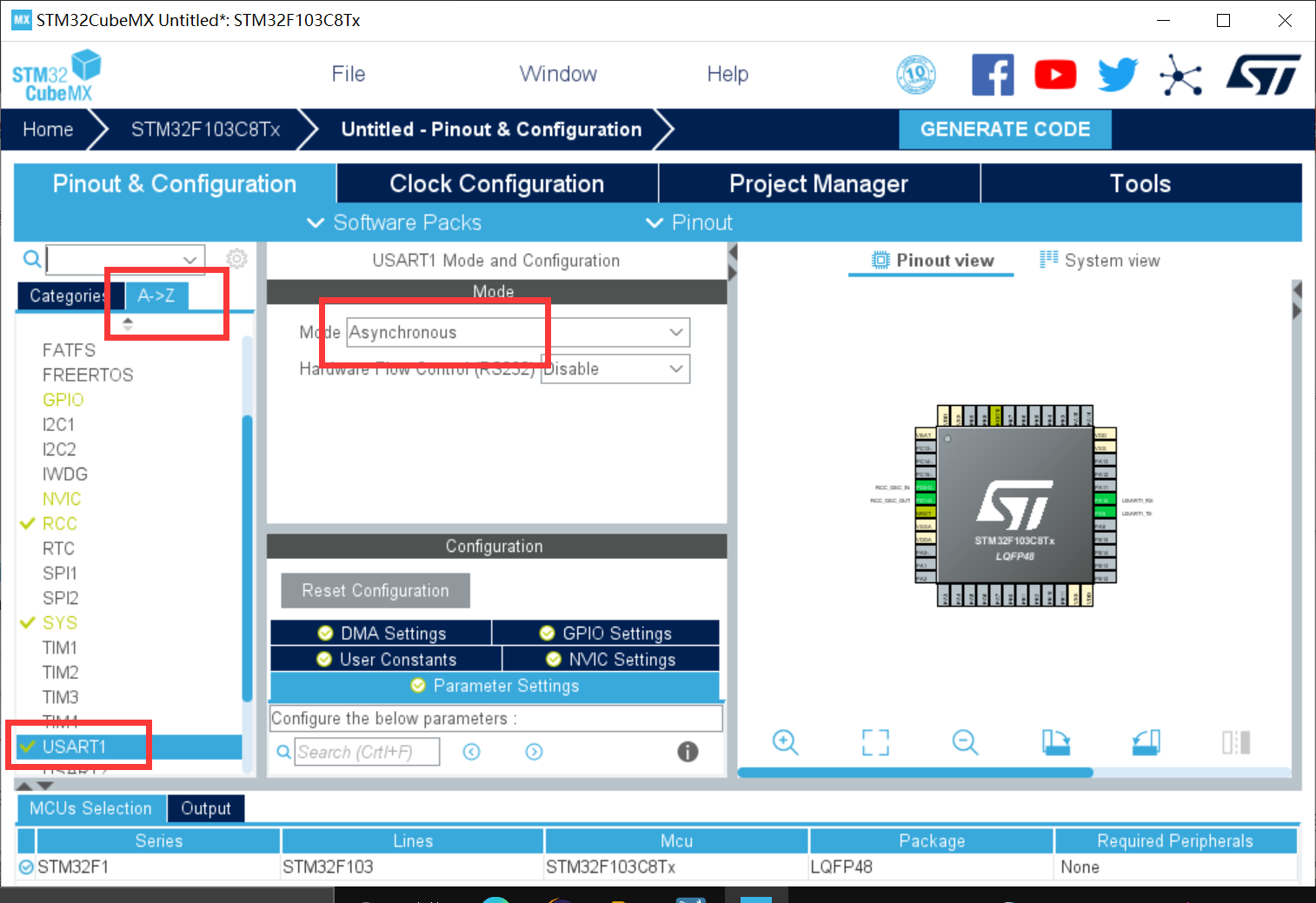
Click Clock Configuration and select PLLCLK.
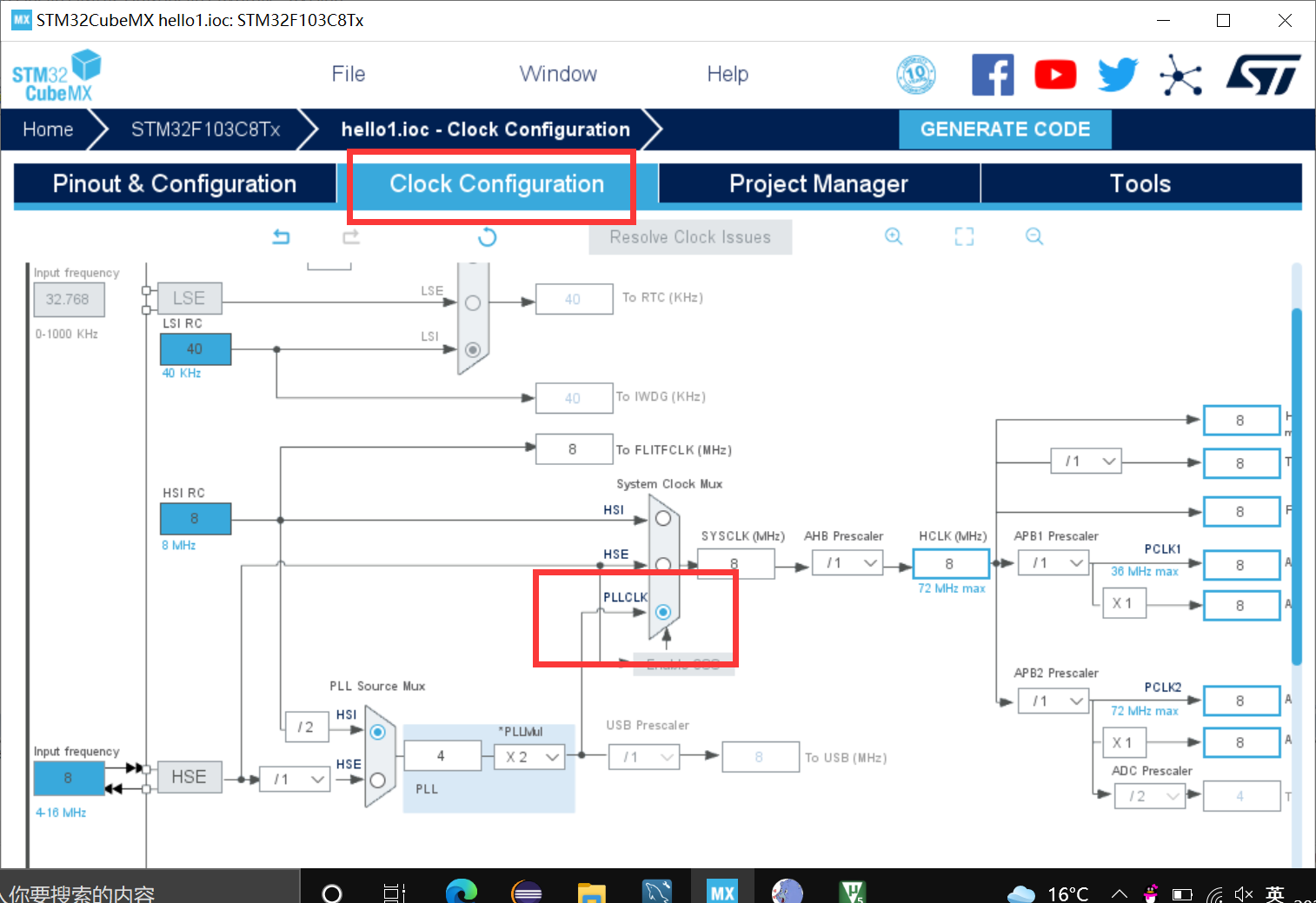
Click project manager to fill in the path and project name.
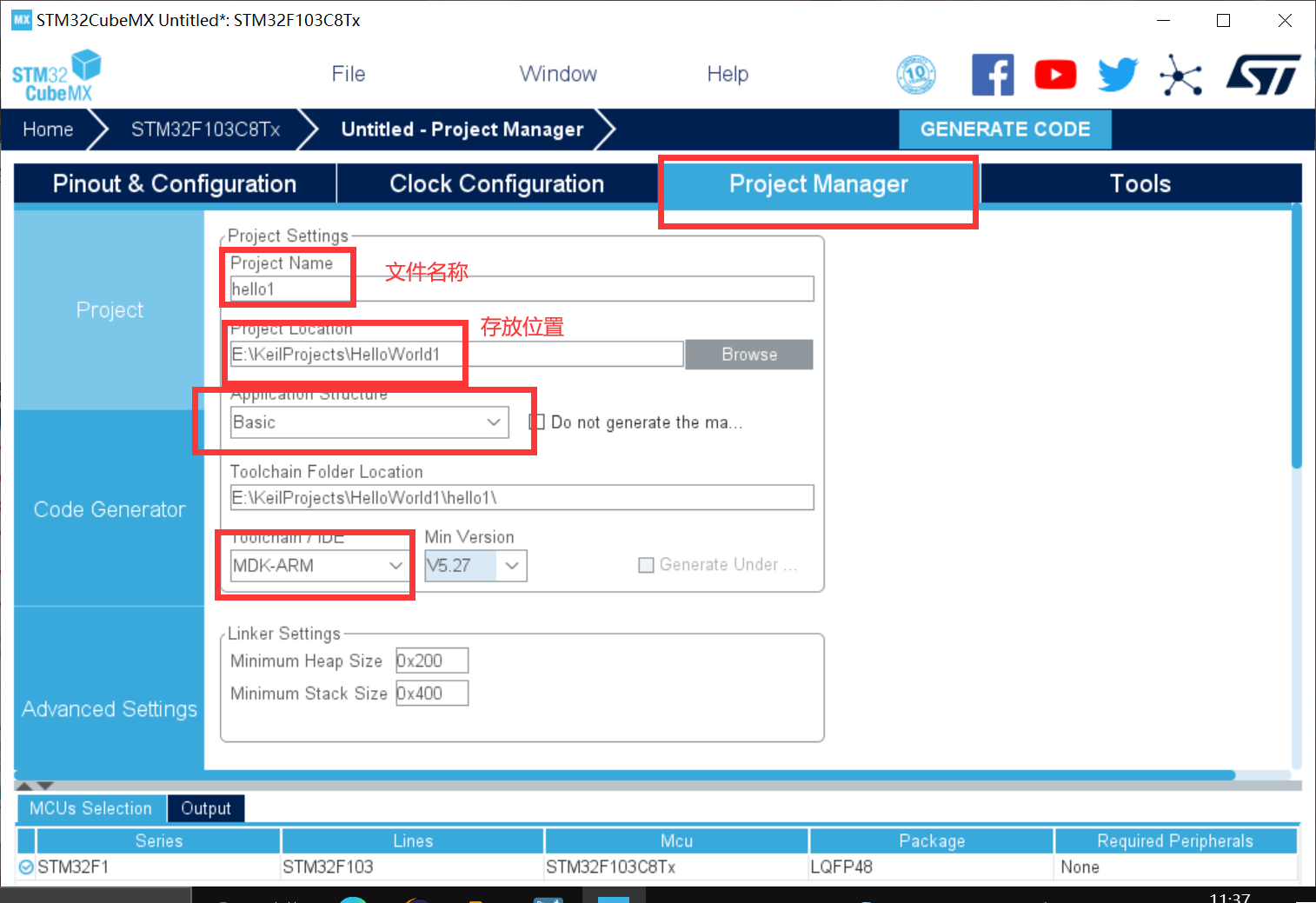
Enter the code generation interface, select Generate initialization.c/.h file, click generate code, and wait.
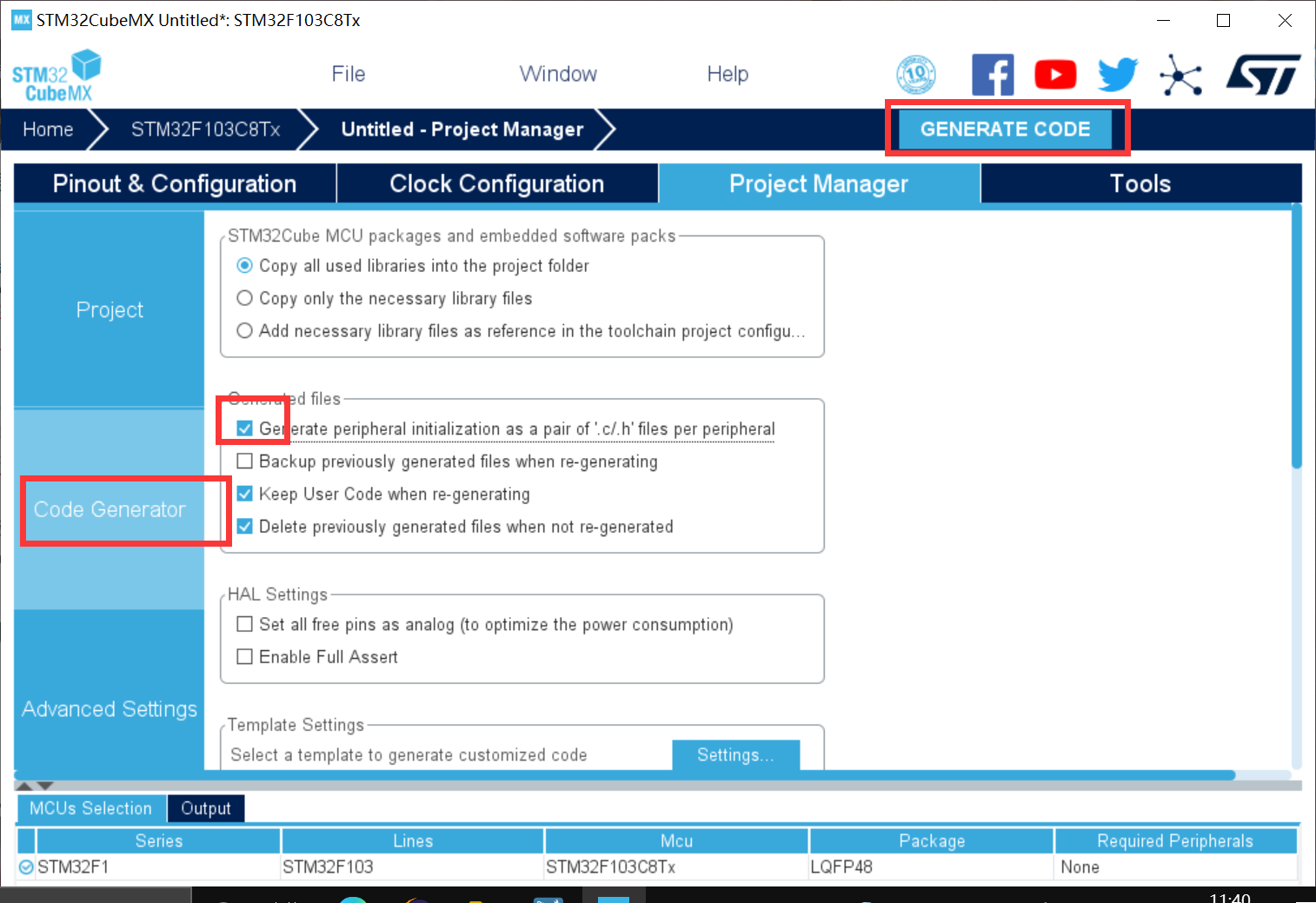
Click Open to open from Keil.
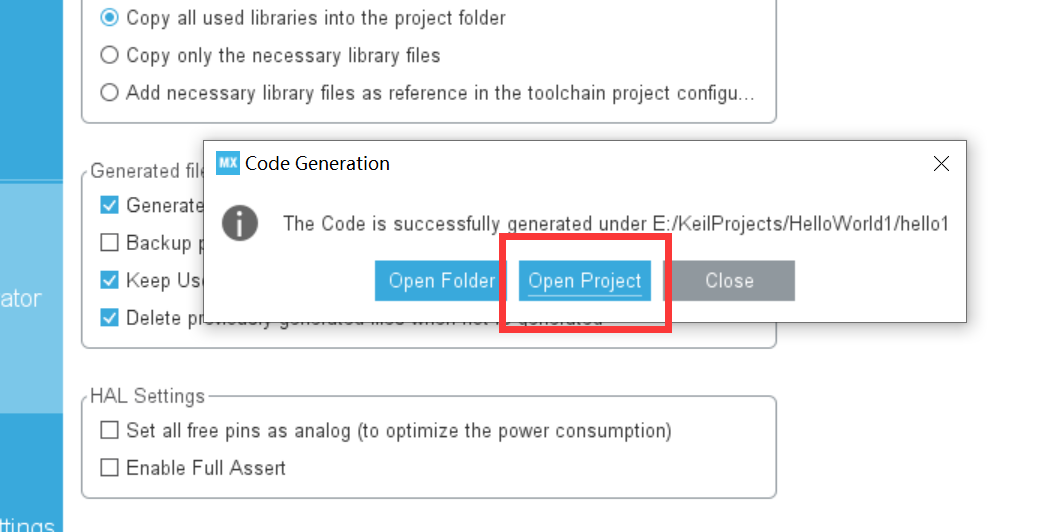
(2) main.c code modification
After opening with Keil, click on the main.c file to find the while function to add code to it to implement the function.
char data[]="hello windows!\n"; HAL_UART_Transmit(&huart1, (uint8_t *)data, 15, 0xffff); HAL_Delay(1000);
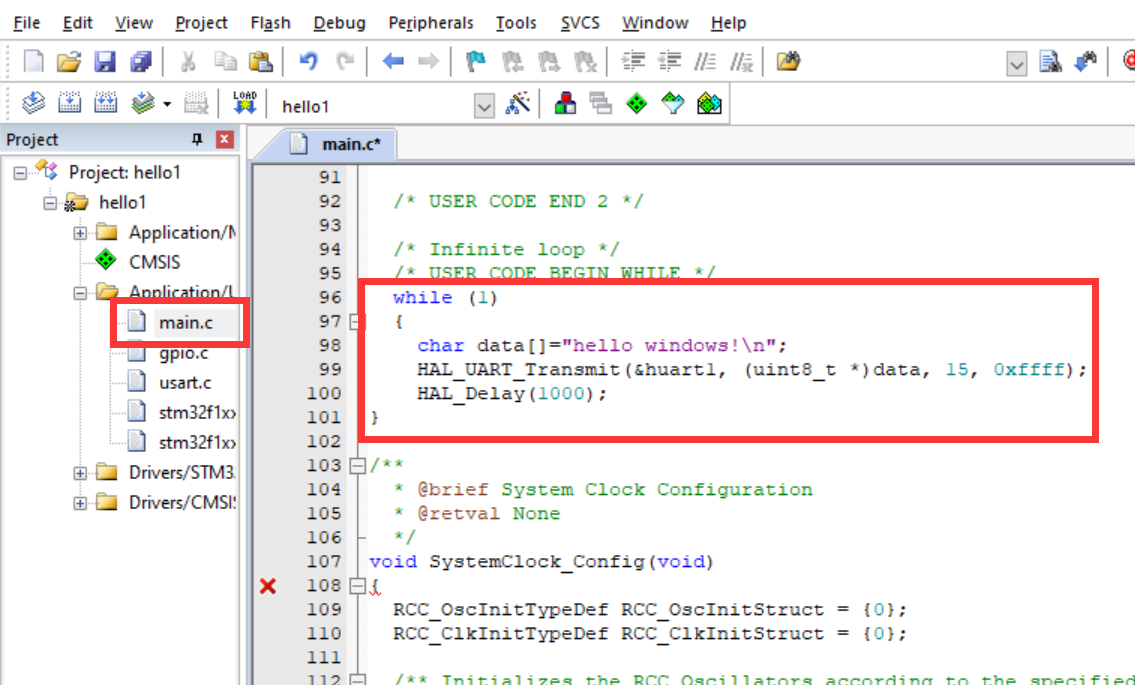
Compile.
(3) Burning
boot0 at 1, boot1 at 0

(4) Serial output results
Boot0 at 0,Boot1 at 1
Debug with wildfire multi-function debugging assistant, open the serial port, and output successfully.

(5) Analyzing waveforms
Click on the magic wand to set Debug.
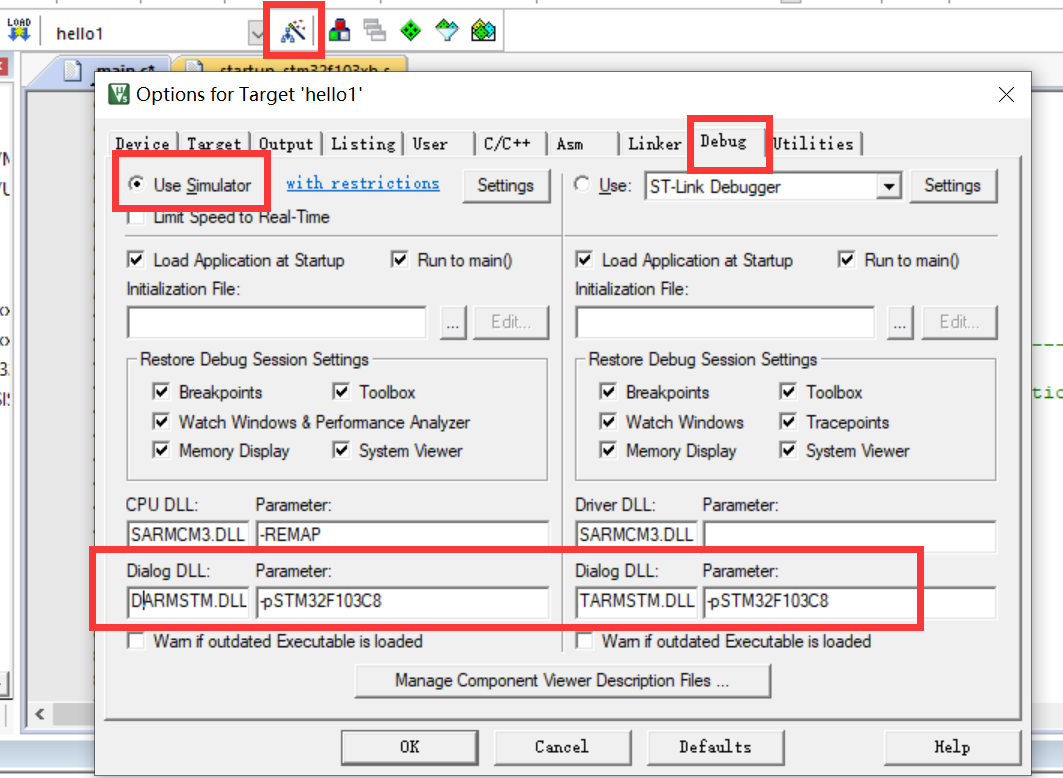
Debugging.
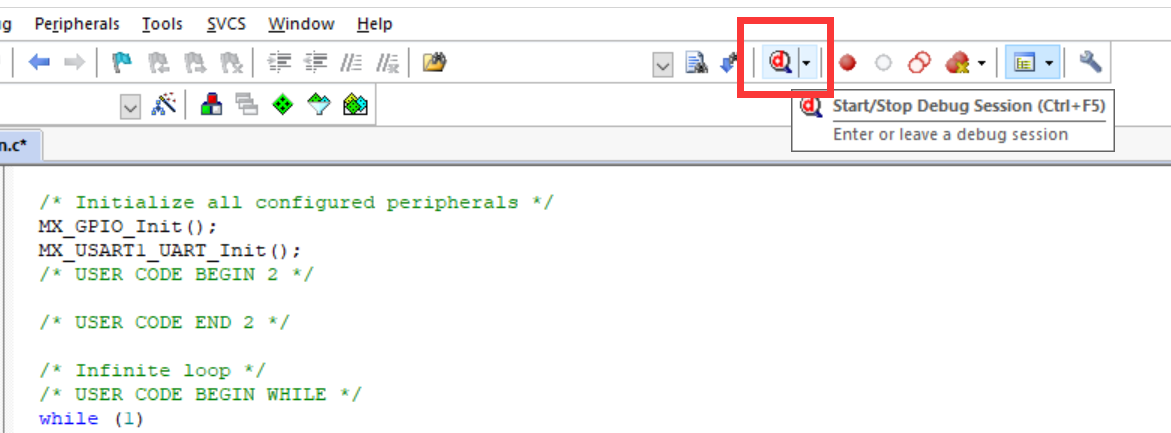
Select a logical analyzer.
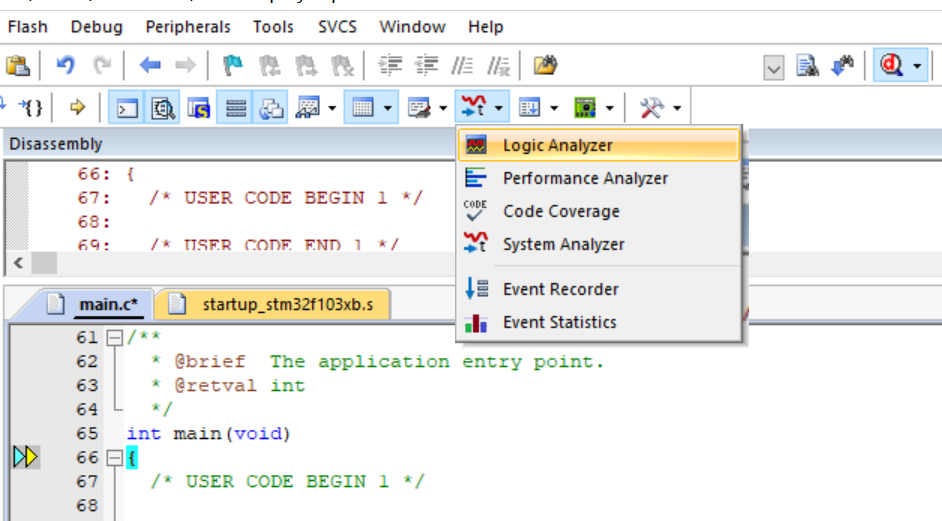
Click Setup.

Run once, output the result.
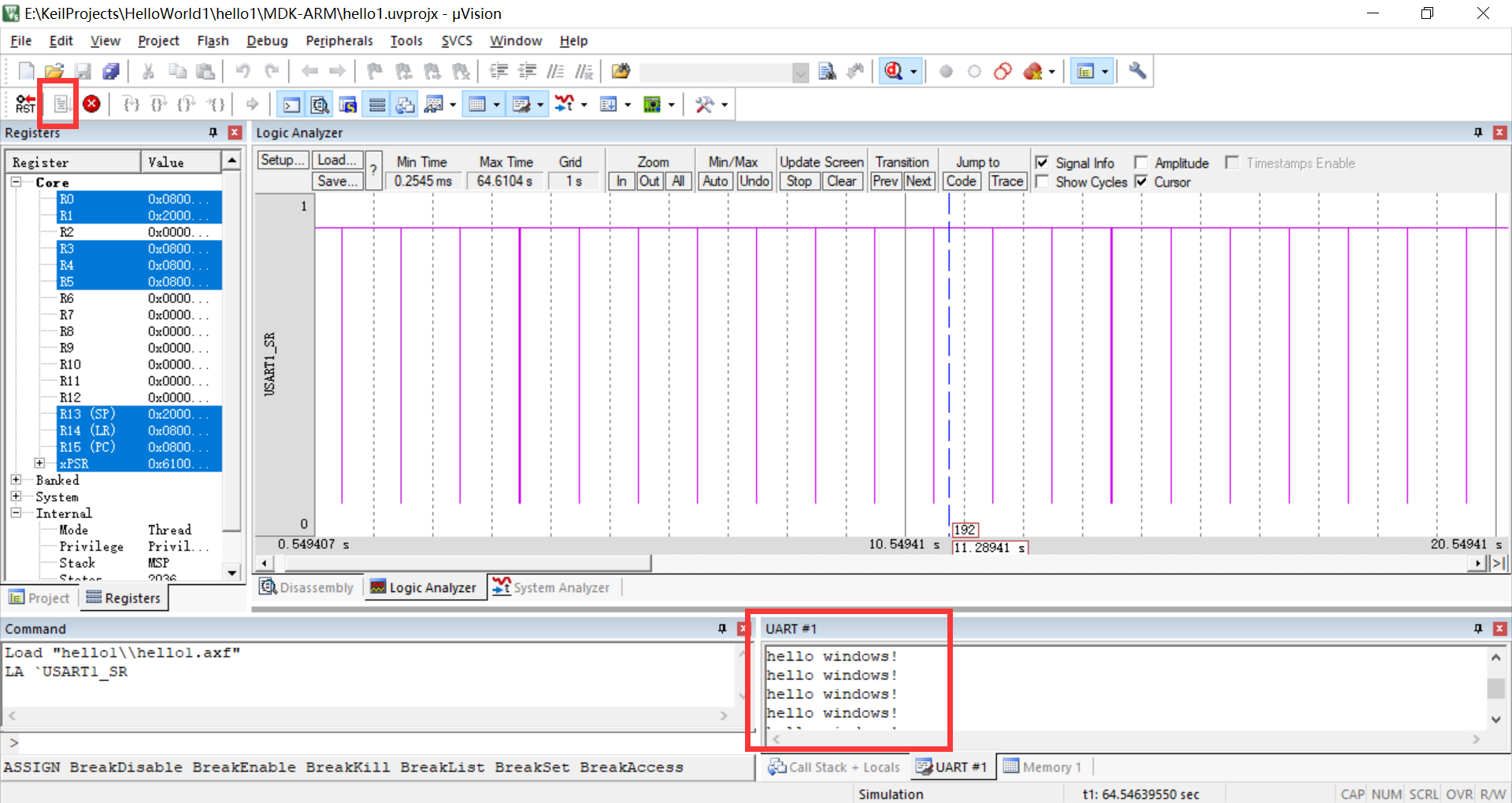
Reference
STM32 Minimum Core Board F103 Serial Communication USART
STM32 Serial Communication Output Hello Window
STM32 Assembler - Serial Output Hello world